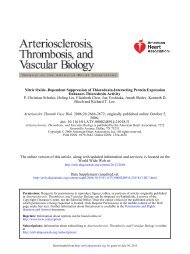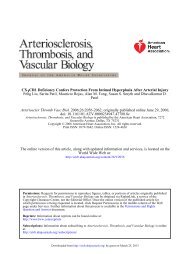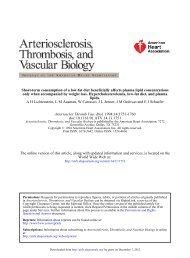Oral Presentations - Arteriosclerosis, Thrombosis, and Vascular ...
Oral Presentations - Arteriosclerosis, Thrombosis, and Vascular ...
Oral Presentations - Arteriosclerosis, Thrombosis, and Vascular ...
You also want an ePaper? Increase the reach of your titles
YUMPU automatically turns print PDFs into web optimized ePapers that Google loves.
into fibrin gels by day 7, characterized by dense (242 /- 6 vessels/mm2) networks of small<br />
vessels (diameter 10.7 /- 0.4 microns) expressing high levels of VEGF, TGF-b1, bFGF, <strong>and</strong><br />
Ang-1 throughout the tissue. By 14 days the networks are more dense (326 /- 28<br />
vessels/mm2) with a broader range of vessel sizes (10.7 /- 1.4 microns). VEGF <strong>and</strong> TGF-b1<br />
levels remain high, while bFGF, <strong>and</strong> Ang-2 are decreased. Spatially, 14 day TGF-b1 expression<br />
localizes to larger vessels in the fibrovascular tissue near the muscle interface. Ang-2 <strong>and</strong> bFGF<br />
expression decreased at the interface but remained high deeper in the gel.<br />
ADAM-TS <strong>and</strong> Plasmin-Mediated Degradation of Versican during<br />
Flow-Induced Intimal Atrophy in Baboon Polytetrafluorethylene (PTFE)<br />
Grafts<br />
P256<br />
Richard D Kenagy, Jens Fischer, Mark Davies, Scott Berceli, John S<strong>and</strong>y, Suzanne Hawkins,<br />
Thomas Wight, Alex<strong>and</strong>er Clowes. University of Washington, Seattle, WA; University of South<br />
Florida, Shriners Hospital, Tampa, FL; Hope Heart Institute, Seattle, WA<br />
In a bilateral aorto-iliac PTFE graft model of intimal atrophy in baboons, high blood flow caused<br />
by placement of a downstream arterio-venous fistula causes intimal atrophy in the upstream<br />
graft. We have investigated whether matrix degrading proteinases are altered in this model of<br />
atrophy using the normal flow side (no fistula) as a control. After four days of high flow intimal<br />
urokinase was increased (5.03.1 fold of normal flow; p.05; n5) <strong>and</strong> plasminogen<br />
activator inhibitor-1 was decreased (0.430.15 fold of normal; p.05; n5). After 7 days<br />
plasminogen, proMMP2, <strong>and</strong> proMMP9 were increased 3.31.2, 1.230.06, <strong>and</strong> 1.440.18<br />
fold of normal, respectively (p.05; n5). Extracts of 4 day high flow intimas degraded more<br />
35 S-methionine labeled versican (the major proteoglycan of the intimal matrix) compared to<br />
normal flow intimal extracts (114% vs 328% of versican remaining, respectively; p.05;<br />
n5). Degradation was inhibited by the serine proteinase inhibitor, AEBSF, <strong>and</strong> a blocking<br />
antibody to plasmin , but not by the MMP inhibitor, BB94. Increased amounts of a 70 kD<br />
N-terminal fragment of versican V1 cleaved at E 441 -A 442 were detected in the intima by western<br />
analysis (7.24.9 fold of normal flow; p.03; n6) <strong>and</strong> immunostaining using a neoepitope<br />
specific antibody (S<strong>and</strong>y et al J Biol Chem 276:13372, 2001). This neoepitope is specific for<br />
ADAM-TS enzymes. ADAM-TS4 <strong>and</strong> ADAM-TS5, but not ADAM-TS1 (TS4 <strong>and</strong> TS1 are known<br />
to cleave versican at E 441 -A 442 ), protein were detected in intimal extracts. While ADAM-TS4<br />
content was not markedly changed, ADAM-TS5 was decreased at 4 days by high flow<br />
suggesting other ADAM-TSs mediate 70 kD DPE production. It is also possible that activated<br />
ADAM-TSs lose C-terminal TS domains, which mediate binding to the ECM, <strong>and</strong> are lost from<br />
the tissue. In summary, these data suggest that plasmin <strong>and</strong> ADAM-TS enzymes mediate<br />
versican removal during flow-induced intimal atrophy in the baboon PTFE graft.<br />
P257<br />
Rho Regulates Extracellular Matrix-Mediated Activation of Arterial Smooth<br />
Muscle Cells<br />
Joy Roy, Bimma Henderson, Johan Thyberg, Ulf Hedin. Karolinska Hospital, Stockholm,<br />
Sweden; Karolinska Institutet, Stockholm, Sweden<br />
The activation of vascular smooth muscle cells (SMCs) from a contractile to a synthetic<br />
phenotype is a prerequisite for the migration <strong>and</strong> proliferation of these cells after arterial injury.<br />
This process is dependent on changes in the extracellular matrix composition <strong>and</strong> includes<br />
major changes in SMC structure <strong>and</strong> function. However, the molecular mechanisms involved<br />
are not known. We have previously shown that integrin-linked tyrosine kinase activity <strong>and</strong><br />
ERK1/2 activation are necessary for phenotypic modulation. The rho GTPases have been shown<br />
to regulate signaling pathways that mediate cytoskeletal reorganization <strong>and</strong> focal adhesion<br />
formation. 3-hydroxy-3-methylglutaryl coenzyme A reductase inhibitors (statins) are known to<br />
block rho activation by inhibiting the synthesis of mevalonate <strong>and</strong> its derivatives that are<br />
involved in protein prenylation. In this study, we investigated the effect of mevinolin <strong>and</strong><br />
simvastatin, two lipophilic statins, <strong>and</strong> the specific rho activation inhibitor, C3 exoenzyme, on<br />
phenotypic modulation of SMCs during primary culture of freshly isolated rat aortic SMCs on<br />
a substrate of fibronectin under serum-free conditions. Treatment with C3 exoenzyme or statins<br />
blocked focal adhesion formation, cell spreading, induction of cyclin D1, <strong>and</strong> phenotypic<br />
modulation as judged by electron microscopy <strong>and</strong> by western blotting of SMC -actin. Addition<br />
of mevalonate <strong>and</strong> geranyl-geranyl pyrophosphate but not cholesterol or farnesyl pyrophosphate<br />
could reverse the effects of mevinolin. In addition, we detected that a smaller fraction<br />
of rho was translocated to the cell membrane in statin-treated cells as compared to control<br />
cells. These results supported the idea that the geranyl-geranylated proteins such as rho, rac<br />
<strong>and</strong> cdc42 were involved. Our results suggest that rho activation is necessary for SMC<br />
phenotypic modulation <strong>and</strong> that statins inhibit this process by preventing prenylation of rho<br />
proteins.<br />
Does Manganese Deficiency Reduce Arginase Activity to an Extent<br />
Whereby <strong>Vascular</strong> Function is Altered?<br />
Fatima A Tenorio, Jodi L Ensunsa, Carl L Keen, J D Symons. University of California Davis,<br />
Davis, CA<br />
P258<br />
Arginase is a manganese-containing enzyme that catalyzes the hydrolysis of arginine to form<br />
ornithine <strong>and</strong> urea. Nitric oxide synthase is an enzyme that catalyzes the hydrolysis of arginine<br />
to form nitric oxide <strong>and</strong> citrulline. Animals lacking dietary manganese have reduced arginase<br />
activity. We tested the hypothesis that manganese deficiency decreases arginase activity to an<br />
extent whereby arginine is diverted through the nitric oxide synthase pathway, resulting in<br />
enhanced endothelium-dependent relaxation. Female rats consumed a manganese (Mn)<br />
sufficient (45 mg Mn / kg of diet; n6) or Mn deficient diet (0.5 mg Mn / kg of diet, n6)<br />
for 632 days. After anesthetizing each animal, sections of liver, abdominal aorta, <strong>and</strong> the<br />
entire heart were excised. Liver Mn (3.40.8 Downloaded vs 41.24.4 nmol/g) from<br />
<strong>and</strong> arginase activity<br />
http://atvb.ahajournals.org/<br />
Poster <strong>Presentations</strong> a-45<br />
(0.70.2 vs 1.90.4 U/mg) were lower (p0.05) in Mn-deficient vs Mn-sufficient animals,<br />
respectively. Aortic segments (640 m, internal diameter) <strong>and</strong> coronary microvessels (118<br />
m, i.d.) were mounted on wire myographs <strong>and</strong> endothelium-dependent <strong>and</strong> independent<br />
functions were evaluated using acetylcholine (ACh) <strong>and</strong> sodium nitroprusside (SNP), respectively.<br />
In aortic segments that were precontracted with norepinephrine, maximal ACh-evoked<br />
relaxation was greater (p0.05) in Mn-deficient (797%) vs Mn-sufficient (549%) animals,<br />
while SNP-evoked relaxation was similar between groups (1012% vs 1083%, respectively).<br />
In coronary vessels precontracted using endothelin-1, maximal ACh-evoked relaxation<br />
(5516% vs 529%) <strong>and</strong> SNP-evoked relaxation (10521% vs 10310%) were similar in<br />
Mn-deficient vs Mn-sufficient rats, respectively. These data indicate that manganese deficiency<br />
enhances endothelium-dependent relaxation in aortic but not coronary vessels. Therefore, the<br />
vascular effects of reduced arginase activity resulting from manganese deficiency appear to be<br />
heterogeneous throughout the vasculature.<br />
Role of the Plasminogen System in the Inflammatory Response to<br />
Biomaterial Implants<br />
P259<br />
Steven J Busuttil, Victoria A Ploplis, Edward F Plow. Case Western Reserve University<br />
Clevel<strong>and</strong> VAMC, Clevel<strong>and</strong>, OH; W M Keck Center for Transgene Research, University of<br />
Notre Dame, Notre Dame, IL; Joseph J Jacobs Center for <strong>Thrombosis</strong> <strong>and</strong> <strong>Vascular</strong> Biology<br />
<strong>and</strong> the Clevel<strong>and</strong> Clinic Foundation, Clevel<strong>and</strong>, OH<br />
Recent evidence speculates that the plasminogen (Plg) system may play a profound role in<br />
mediating cellular recruitment during the inflammatory response. Utilizing a peritoneal<br />
biomaterial implant model in mice deficient in components of the plasminogen system, we<br />
found that both neutrophil (Neut) <strong>and</strong> macrophage (M) recruitment was significantly<br />
attenuated in the absence of Plg. The present studies were undertaken to elucidate the<br />
molecular mechanism by which the Plg system influences the inflammatory response to<br />
biomaterial implants. This model involves surgical placement of polyethylene terephthalate<br />
disks into the peritoneum of mice. Leukocytes are recovered from peritoneal lavage after 18<br />
hrs <strong>and</strong> M <strong>and</strong> Neut populations are distinguished by enzyme activity assays. In mice treated<br />
parenterally with tranexamic acid, an antagonist of the lysine binding sites of Plg, there was<br />
a significant decrease in both M <strong>and</strong> Neut recruitment (p0.001). Mice treated subcutaneously<br />
with aprotinin, an active site inhibitor of plasmin activity, showed no attenuation in<br />
leukocyte recruitment. In addition, mice treated with intraperitoneal aprotinin showed no<br />
significant change in M recruitment <strong>and</strong> only a non-significant decrease in Neut recruitment,<br />
although the doses of aprotinin were sufficient to suppress plasmin activity. M <strong>and</strong> Neut<br />
recovered from the peritoneal lavage were used in an in-vitro fibrin degradation assay. M<br />
from both wild-type <strong>and</strong> plasminogen-deficient mice displayed a low baseline ability to degrade<br />
fibrin (8.9% <strong>and</strong> 9.2%, respectively). The fibrinolytic activity of the M increased in the cells<br />
of both strains of mice (24.9% <strong>and</strong> 19.2%, respectively) after the addition of exogenous<br />
plasminogen, indicating a similarity in the capacity of the cells to form active plasmin. In<br />
conclusion, these studies provide in-vivo verification that the plasminogen system plays an<br />
integral role in inflammatory cell recruitment <strong>and</strong> indicates that the lysine binding sites of<br />
plasminogen are critical in this response. Manipulation of the function of the lysine binding sites<br />
of plasminogen may provide a means for controlling the inflammatory response to biomaterials.<br />
P260<br />
A Dominant-Negative Variant of Nuclear Receptor TR3 Aggravates <strong>Vascular</strong><br />
Lesion Formation<br />
Karin E Arkenbout, Vivian De Waard, Maaike Van Bragt, Tanja A Van Achterberg, Bruno<br />
Pichon, Hans Pannekoek, Carlie J De Vries. Academic Medical Center, Amsterdam,<br />
Netherl<strong>and</strong>s; IRBHHN, Gosselies, Belgium<br />
<strong>Vascular</strong> smooth muscle cells (SMCs) can undergo relatively rapid <strong>and</strong> reversible changes in<br />
phenotype in response to local environmental alterations, which occur during atherogenesis.<br />
Transcription factors are key regulators in phenotypic changes of SMCs. Upon activation of<br />
human SMCs with an atherogenic stimulus we found that the mRNA expression of all three<br />
members of the Nerve Growth Factor Induced gene-B (NGFI-B) subfamily of nuclear hormone<br />
receptors is induced rapidly <strong>and</strong> transiently. This subfamily comprises TR3 orphan receptor<br />
(TR3), Nuclear receptor Of T-cells (NOT) <strong>and</strong> Mitogen Induced Nuclear Orphan Receptor<br />
(MINOR). In addition, NOT is expressed in differentiating THP-1 cells, whereas MINOR mRNA is<br />
induced both in THP-1 <strong>and</strong> MonoMac6 cells. In agreement with the expression profiles of these<br />
genes in vitro, TR3, NOT <strong>and</strong> MINOR mRNA is absent in normal vascular tissue, whereas each<br />
of these genes is expressed in neointimal SMCs in human atherosclerotic lesions derived from<br />
thirteen different individuals. Especially NOT <strong>and</strong> MINOR are also expressed in lesion<br />
macrophages. To reveal the function of these nuclear receptors in atherogenesis, we applied<br />
a variant of TR3 that lacks the transactivation domain (TA) but exhibits normal DNA binding<br />
<strong>and</strong> consequently functions as a dominant-negative inhibitor of all three subfamily members.<br />
Adenoviral overexpression of TA in primary SMCs resulted in enhanced DNA synthesis as<br />
illustrated by a 10-fold increase in 3H-thymidine incorporation. Homozygous, transgenic mice<br />
were generated overexpressing TA under control of the SM22-promoter, resulting in arterial<br />
SMC-specific expression. Three founders were bred <strong>and</strong> show no obvious phenotype <strong>and</strong> aorta<br />
<strong>and</strong> carotid arteries exhibit normal morphology. Challenge of TA transgenic mice in the<br />
carotid artery ligation model results in a 4-fold increase in neointima/media ratio. Based on<br />
these data we hypothesize that NGFI-B subfamily members inhibit SMC proliferation in<br />
atherogenesis <strong>and</strong> that the lig<strong>and</strong>s of these orphan receptors may serve as powerful<br />
therapeuticby tools guest in vascular on April disease 4, involving 2013 excessive SMC proliferation.














